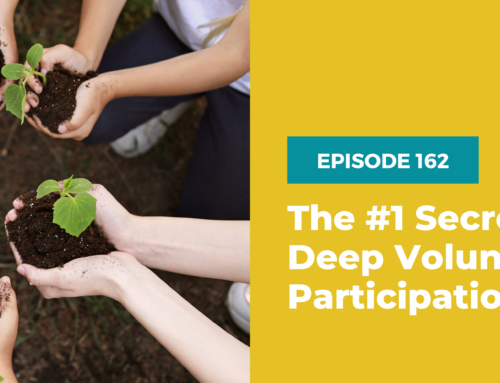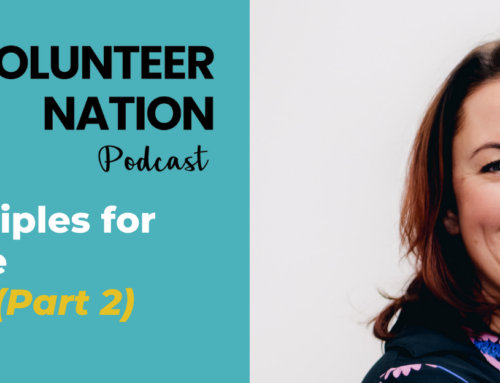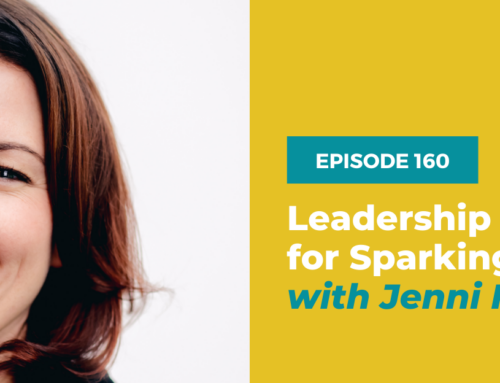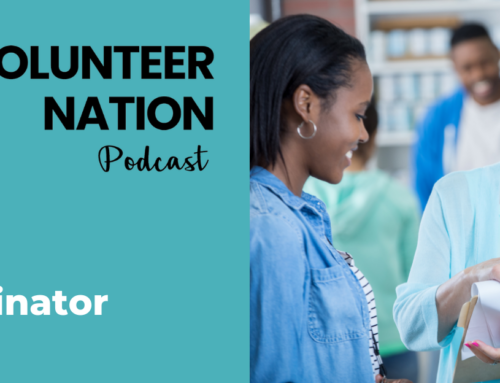
April 10, 2025
Episode #157: A Fresh Take on Volunteer Position Descriptions
In this episode of The Volunteer Nation Podcast, Tobi Johnson challenges the status quo of traditional volunteer position descriptions. She explores why the standard, task-heavy approach often falls flat and shares how a simple shift in language and structure can dramatically improve volunteer recruitment.
Tobi introduces creative alternatives—like adding impact statements, showcasing team values, and sharing volunteer testimonials—that speak to both the hearts and minds of prospective volunteers. You’ll also hear practical, easy-to-implement tips, such as renaming your descriptions to “Volunteer Opportunities” and reframing responsibilities as meaningful accomplishments.
If you’re looking to attract more passionate and committed volunteers, this episode is packed with fresh ideas to help you do just that.
Volunteer Position Descriptions – Episode Highlights
- [00:29] – Reevaluating Volunteer Position Descriptions
- [01:03] – Challenges in Volunteer Recruitment
- [02:04] – Traditional Volunteer Position Descriptions
- [05:20] – Fresh Take on Volunteer Position Descriptions
- [10:27] – Aligning Volunteer Descriptions with Volunteer Needs
- [14:05] – Do This, Not That: Revamping Volunteer Descriptions
Volunteer Position Descriptions – Quotes from the Episode
“I like to say volunteers don’t. Join us because they enjoy working for free. They join our organizations because they want to change the world. It’s a completely different mindset than an employee.”
“If you’re more volunteer centric and you help volunteers with their informational and emotional needs at this inquirer stage, when they’re really considering whether or not they’re going to commit, you’ll be more likely to attract the people you seek rather than turning them off with bureaucratic language.”
Helpful Links
- VolunteerPro™ Impact Lab
- 2025 Volunteer Management Progress Report – The Recruitment Edition
- Volunteer Nation Episode #019: Improve the Volunteer Experience with a Journey Map
- Volunteer Nation Episode #146 – Expanding Volunteer Jobs to Be Done at Your Nonprofit
- Volunteer Nation Episode #101: Tap the Power of Psychological Contracts with Pam Kappelides
About the Show
Nonprofit leadership author, trainer, consultant, and volunteer management expert Tobi Johnson shares weekly tips to help charities build, grow, and scale exceptional volunteer teams. Discover how your nonprofit can effectively coordinate volunteers who are reliable, equipped, and ready to help you bring about BIG change for the better.
If you’re ready to ditch the stress and harness the power of people to fuel your good work, you’re in exactly the right place!

Contact Us
Have questions or suggestions for the show? Email us at wecare@volpro.net.
Rate, Review, & Follow Us on Apple Podcasts
If you love the content Tobi shares on the Volunteer Nation podcast, consider rating and reviewing the show! This helps us reach more people – and help more good causes just like yours – successfully engage enthusiastic, dedicated volunteers with less stress and more joy.
Click here, scroll to the bottom, tap to rate with five stars. Then, select “Write a Review” and let us know what you loved most about this episode!
Also, if you haven’t done so already, follow the podcast so you don’t miss a thing. Follow now!
Subscribe to ProNews: Our Weekly Resource Roundup
If you’d like to stay up to date on all new podcasts, blogs, freebies, and deals posted on our Tobi Johnson & Associates and VolunteerPro websites, subscribe to our weekly ProNews newsletter.
Every Wednesday, we’ll send you a digest of our freshest content, plus a bonus! Once you confirm your subscription, you’ll get our [Free eBook] The New Volunteer Manager: The First 90 Days.
Episode #157 Transcript: A Fresh Take on Volunteer Position Descriptions
Tobi: Hello my friends. Welcome to another episode of The Volunteer Nation Podcast. I’m your host, Tobi Johnson, and today I want to call out something that is such a tried-and-true tradition. It’s sort of a quote unquote best practice, but I want to call it out and reconsider it. And those are our position descriptions. I want to do a fresh take on volunteer position descriptions. I think they’re in major need of an upgrade.
And let me just give you a little bit of context for this. First of all, in this year’s volunteer management progress report, the recruitment edition, we found that volunteer recruitment continues to be a perennial challenge for volunteer organizations. 26.4% of. All respondents listed this as their top challenge in our open-ended comments, and this has been consistent throughout the 10 years of the survey.
I think one year during the pandemic; it was supervision basically around remote volunteering was the top. Challenge, but it’s just something we continually are challenged by, and it’s part of our job, right? If we’re attracting volunteers, it’s a big part of what we do. So, I’m always seeking ways to improve our communications with prospective volunteers so that our recruitment strategies can be more effective and volunteer position descriptions are a key tool in this process. According to our research, in our volunteer management progress report, we found that 63.4% of all volunteers involving organizations always have their position description in place prior to recruitment campaigns. Only 4.8% never have that volunteer position description in place.
The rest of the in between folks are, sometimes they don’t. So, it’s such a prevalent practice in our field, but it always kind of hits me in the gut whenever I would develop them or work with my consulting clients or train. I’ve obviously trained quite a bit in position descriptions in our courses and community.
But it’s always kind of, I’ve always had a hard time with it. I always felt like they felt dry and boring and bureaucratic, and I thought. How do these really inspire people? And at some point, our volunteer sector decided that emulating human resources practices made sense. But I am starting to call into question whether they do, does volunteerism need to emulate employee HR?
Job descriptions are part of employee hr. There are legal. Issues around position descriptions, job descriptions, especially if you’re working in a union environment, but also paid staff are being evaluated on their job description. Their pay is being set based on the tasks and skills required by the job description.
It’s a compliance tool, and yes, to communicate with potential employees, but volunteers aren’t employees, and they don’t, you know, I like to say volunteers don’t. Join us because they enjoy working for free. They join our organizations because they want to change the world. It’s a completely different mindset than an employee, but we continue to treat them as some kind of, you know, quasi employee.
When we write up job, volunteer position descriptions or job descriptions, it’s always stuck in my gut a little bit when I’ve put these together. And of course. They tend to be a huge laundry list of requirements that. The perfect human couldn’t even meet half the time. And we think, I think that the thought is if we get this all down on paper perfectly, then we’ll find the perfect quality volunteer and they will follow all the rules and life will be perfect and we will have less drama and we will get more results.
You know what? A piece of paper rarely has that kind of power. It’s more people to people that have the power, right? The relationships we have, the contracts, we’ve talked about psychological contracts here on the podcast, but you know, the social contracts we have with one another. Those are the things that are powerful, not what’s on a piece of paper.
I wanted to do a little research on this, so I poked around inside the Volunteer Pro Impact Lab, our membership community. We have a Wisdom AI widget that basically works like chat GBT, but it only scrapes my content. So only the transcriptions of my replay recordings of all our seminars. We have hundreds of them in our library, and then all of my Volunteer Nation podcast episodes like this one.
So, it’s interesting. I wanted to see what my own content is? What does the AI widget, what does the AI bot say about what I’m saying to my students and members about volunteer position descriptions? So, here’s what I found, because I asked the wisdom AI widget, give me a list of things to put in a volunteer position description.
I wanted to check my own teaching, right? So, first, these are all the traditional things that I always teach on, that we all always teach on, that we were taught ourselves that are considered quote unquote best practice that we continue to lean on. And maybe they’re okay, but I want to offer in this podcast episode some alternatives. So, we’re going to do a little, do this, not that after the break, but first I want to go through what our traditional looks like. So, setting the stage, especially for those of you who are new to the field or are an executive director and you don’t really write up volunteer position descriptions.
This is what we generally include. This is what my AI bot says. In terms of what I’m teaching folks. So, one is the goals of the position and impact statement. So, a statement outlining who benefits from the volunteer activities, what, what are the goals of the position, that kind of thing. Kind of an overview.
Then we always have a list of duties and responsibilities, so that’s a clear bulleted list of what the volunteer will handle and be responsible for. We. Often have time requirements, so what’s the time commitment, what’s the schedule, et cetera. We also often include a location where the volunteering will take place so people can plan their time and make sure it’s the right fit for them.
Minimal skills and qualifications, or minimum, I should say, the basic skills and qualifications, KSAs knowledge, skills, and abilities for the position. These sometimes can get long. I always coach people to keep these short and tight. Orientation and preparation for the role. So, what’s the training that volunteers will be involved with?
If it’s an intense role that with a lot of training, the language around this is often around requirements, training, requirements, support and supervision, how the volunteer will be supported and by who will be their supervisor. Benefits and perks. So, any rewards volunteers will receive could be free parking.
Bus passes, discounts, training, making friends, all kinds of stuff and contact information. I’m always recommending a real human contact with a phone number and an email or a booking link to set up a quick 15-minute info call. And those are the things traditionally that we include on our volunteer position descriptions, I have to say.
I don’t think these really meet the needs of our newcomers or peak the interest of our volunteers. They all kind of look the same and they don’t really meet true volunteer needs. Now, what do I mean by volunteer needs? I’m going to share that in a minute. But I also want to just point out that if you’re wondering, you may be thinking about volunteer position descriptions, but you might be also wondering, well, what kind of role should I be developing for the future to fuel my mission?
So, if you’re thinking beyond position descriptions to designing which roles you’re going to bring on board, I have a great episode for you. It’s Volunteer Nation, episode 146. Expanding volunteer jobs to be done at your nonprofit, where I give you a full step-by-step process on how to expand roles across your organization.
If you’re thinking about role design and then what kind of roles, check that out. But let’s get back to this discussion of volunteer position descriptions. Let’s look at how they might better align with the needs of prospective volunteers as they consider joining. And I’ve got some. Recommendations for fresh elements that we can include that create an informative and inspiring document that can serve as a marketing tool to attract the right volunteers because we are using these to explain the role.
So why not lean into using it as a better marketing and communications tool. So, inside the Volunteer Pro Impact Lab, I teach about aligning steps in the volunteer journey to best meet the informational and emotional needs of prospective volunteers. I also talked about that a little bit in Volunteer Nation, episode 19, improve the volunteer Experience with a Journey map.
So, check that out. But I took that tack when I started to rethink. How can we change and update our volunteer position descriptions so they’re more engaging? And so, I took that approach. What are the informational and emotional needs of a volunteer when they’re at the stage of looking at our volunteer position descriptions?
Now I’m going to assume you’re sharing those with a volunteer prior to them joining. Okay, so I’m going to assume that this is when they’re in the, either prior to the application process or during the application process, but really, I want to talk about prior to the application process, they’re deciding whether this role is right for them and whether they’re going to apply.
Right? So, I’m hoping you’re posting your volunteer position descriptions on your website or linking to them in your posting so that people can get more detail if they want. At this stage, I call this stage the inquirer stage. People are assessing this role. Is it the right role for me? Is this organization the right organization for me?
And they are evaluating because people are much more choosy nowadays because after a global sort of pandemic that called us to really think about how we spend our time, there’s nothing like an existential crisis globally to have people rethink how am I spending my time? So, people are choosier nowadays.
What are they wanting at this enquirer stage on the practical level? They want, the informational needs might be around. They want a friendly, efficient, easy to understand application process. Join us in three to five steps. Just offer three to five quick steps. They want informational needs.
They want clear details on the role, what they would be doing, and whether they’re interested in it. They must evaluate it, right? But they also have a lot of emotional needs at this point in the Enquirer stage where they’re thinking. Is there a true need for this role, for this type of volunteering in the community?
Does this organization really solve community problems? Remember, volunteers are here to change the world, and if they don’t think you’re equipped to do it or that you’re not doing it very effectively or. Why would they join you? Right? So, they’re assessing these things. The other things they’re thinking to themselves are, will I be able to help?
So, this is about confidence. What’s in it for me? Sometimes people have practical needs for their volunteering. Will I belong? That’s a deep-seated human concern and emotional need to connect with people. Will this be enjoyable and fun? Can I learn how to do this if I’m provided training? These are questions, emotional needs that volunteers need to have met at this Enquirer stage.
So, I think we can revamp our volunteer position descriptions to meet these informational and emotional needs better rather than just listing out and emulating what we do with employees. I mean, you could probably use some of these tips with employee position descriptions as well, but they do have a more of a legal element to them.
Let me give you some options. But before we do that, we’re going to take a quick break from my discussion on how to refresh your volunteer position. Descriptions. Don’t go anywhere because right after the break I’m going to launch into a do this, not that. And I’m going to give you some alternatives to the kind of, I got to say, tired, old way. We’ve been doing position descriptions. All right? So don’t go anywhere. I’ll be right back.
VolunteerPro Impact Lab
Hey, are you looking to upgrade and modernize your volunteer program? Or maybe you’re building one from scratch and you’re just not sure where to start. If so, we’ve got the perfect resource for you, the Volunteer Pro Impact Lab.
Having built several direct service programs from the ground up, I know that it doesn’t happen by accident. It’s a clear process that takes careful attention with a focus on impact. In the end, you need a system in place that’s clear, standardized, efficient, and that gets results. In addition, and maybe this is the most important.
You need a volunteer program design that directly contributes to your organization’s most critical goals. That’s where the Volunteer Pro Impact Lab comes in. When it comes to effective volunteer engagement, our bespoke volunteer strategy, success path model, which is the heart of our resources and strategic advising.
We’ll help you transform your volunteer strategy from fundamental to a fully mature what’s working now approach and all in less time. With our online assessment, you’ll quickly gain clarity on precisely where to focus your efforts and we’ll provide recommendations for the exact steps needed for sustainable growth.
Regardless of how large or small your organization is or what your cause impact area or focus is, our program development and implementation support model will help you build a strong foundation so volunteerism can thrive at your good cause. If you’re interested in learning more, go to volpro.net/join and we’ll share how to get started and what’s involved.
All righty. We are back with my chat about volunteer position descriptions and how to quickly make them more impactful and give them a new way to really communicate and engage with our volunteers around their emotional and informational needs. We talked about this inquirer stage that volunteers are at when they are looking at the point they are looking at and reading your position descriptions. So, let’s look at this. Let’s look at ways to change your POS position description so they align with the needs of prospective volunteers as they consider joining. These elements can help create an informative and inspiring document that serves as a marketing piece to track the right volunteers.
What are the needs? We talked about a friendly application process, role details. We talked about all the emotional needs about belonging and efficacy. Can I make and make a difference here? But let’s get down to brass tacks here and talk about doing this, not that. And I’m going to go through the main.
Areas of a position description and offer you alternatives. So, let’s try this. And I’m telling you right now, I think it’s a better take. It’s a fresh take. We need to. I’m just going to editorialize for a minute. There is nothing in what we do that can’t be improved or can’t be called out. Sometimes things are just assumptions that were made 20 or 30 years ago, like, hey, volunteer management should look just like employee management.
The paperwork should be really similar. Maybe not. So, let’s look at do, let’s look at my takes for volunteer, my Fresh Takes for volunteer position descriptions. Do this, not that. All right, so instead of volunteer position descriptions or worse job descriptions, calling them that, how about we call them volunteer opportunities and just include volunteer opportunity at the top of that document.
I feel like it’s a little fresher. I don’t know. Position description is that exciting? Not really. Opportunity. Maybe I want to get behind that. So that’s one. That’s a basic one. Let’s get into some more of these instead of goals for the role, how about impact of the role and offer examples of what other volunteers have done and achieved through the role or the opportunity that you are discussing in that document.
I like that. I like volunteers to get a quick idea about what other volunteers have done and how, why this is important. It lets people know right away, yes, people can make a difference here. I. Here’s another one. Instead of an organization’s mission statement with many organizations, many people will put that at the top of their position description.
How about including a commitment to community statement? I’ve absolutely recommended this to our volunteer pro members, and this came up in my AI widget. I just didn’t include it because it’s not traditionally done. So, let’s talk about this. Instead of the mission statement include a commitment to community statement, which is a short paragraph describing your organization’s rationale for engaging volunteers, the unique value they add and the results they bring about.
So, it’s basically a couple of sentences about why volunteers in the first place, why not just hire some paid staff? And there are lots of reasons, as you all know, why we want to engage the community. So, let’s look at another one. Instead of volunteer policies or rules or requirements or any of that real compliance oriented language.
How about team values and include information about the core beliefs and values that the organization and volunteer teams follow? This helps potential volunteers assess their alignment with. Their own values. Does this organization align? Do their values align with my values? And it’s a more proactive way of sharing the social contract and the psychological contracts that people bring to the position.
I will link to my discussion with Pam about psychological contracts. If you’re, if you don’t know what those are, I’ll add them to the show notes so you can learn more about that. But basically, we come with unspoken expectations and promises that we think the organization is making to us and we’re making to each other.
And so, we want to call those out in a way early on, what do we expect of one another here? And it sets standards, but in a very proactive and inspiring way. So, I’m a huge fan of replacing volunteer policies, rules, regulations, et cetera, with team values. You can train people on policies and procedures later when they’re in their orientation with you, but when you’re marketing and trying to attract volunteers, I personally like team values.
Here’s another one instead of. Including little or no volunteer voice in your document. We don’t hear from volunteers in these documents. They feel very, usually they feel very bureaucratic and dusty. They just feel like they’re not very excited. But how about instead of that? Include volunteer testimonials, quotes from volunteers who have held that specific role about their experience and impact.
Now, we know from some research on psychology that when people understand norms or communicated norms that are really adjacent to what they’re doing. There was this interesting research study years ago about hotel towels and they were testing to see if people would hang up their towels, right?
Instead of throwing them on the floor. They wanted to be more ecologically friendly. They. It included different types of communication, and they were testing to see which would be the most impactful and would really inspire the most people to hang up their towels. Well, the first one was, please hang out your towel.
Be an ecologically friendly person, hang up your towel. The second one was, most people who stay in this hotel hang up their towel, and the third one was. This percentage of people in that have stayed in this room have hung up their towels, and which one do you think was the most impactful? Obviously the one that was most.
Close to the experience of the person staying in that room. So, this is similar when you’re doing testimonials about volunteers. If you could include testimonials from volunteers who have worked in that role, they’re going to be way more impactful. But if you don’t have those yet. Some testimonials from volunteers versus no testimonials of volunteers is always going to be better.
I like to recommend people to include those. Then we include the voice of the volunteer. I love including volunteer tips in volunteer handbooks as well. I love to have asking volunteers to share what they would. Recommend or advice they give newcomers and include those quotes. I’ve done that in a volunteer handbook.
I developed a program before I left and started my consulting practice, and it just brightened up the handbook. It just brought it light and life. So, I like to include, infuse the volunteer voice a little bit. Oh, here’s another one. Instead of training requirements, how about we have a section, what you can learn or what you can learn here?
Dot, dot and list out the things. So, training becomes a benefit, not a requirement. Think about that. Doesn’t that make it more interesting? I mean it’s, it’s much more collaborative and then. Instead of solely listing tasks that a volunteer would be responsible for, how about instead, labeling that section a list of what you will achieve and do, or what you will do and achieve?
Right. It’s just a tweak on it and it feels better. And then finally, instead of minimum qualifications, which I think is so employee centric, it’s not volunteer centric at all. Our volunteers come with a diverse set of qualifications. Now, yes, we do need volunteers to do certain things or to be able, if you’re trying to recruit a data entry, volunteer, certainly knowing how to use a computer is going to be a minimum qualification. But how about we stop calling it minimum qualification? And how about we start calling it people who are in this section, we can just label it people who are successful in this role. dot.do. One of the bullet points might be know how to use a computer, right?
These are just simple ways we can change our volunteer position descriptions, revolutionize what we’ve been doing, or iterate from at least what we’ve been doing in the past and really take a volunteer centric perspective. And last thing I want to say is. Don’t be afraid to try different things out to test these and see which are working better and to get some volunteers to look.
If you’re more volunteer centric and you help volunteers with their informational and emotional needs at this inquirer stage, when they’re really considering whether they’re going to commit, you’ll be more likely to attract the people you seek rather than turning them off with bureaucratic language.
That is, I’m just going to be honest, boring, and tired. I’m just going to say, and I can’t wait for our Wisdom AI widget to relearn these new ways that I’m talking about on this podcast to build volunteer position descriptions that really appeal to volunteers and inspire them to join. Once I post this episode inside our Wisdom a, the backend of our Wisdom AI widget, it should start to learn that there’s a new way to do position descriptions, and it will start pumping out that advice for my members inside the Volunteer Pro Impact Lab.
So that’s kind of fun. I’m going to follow it and see how fast it learns. All right, everybody. That’s it for today’s Volunteer Nation podcast episode. I hope you liked it. If you think it’s helpful, maybe recommend it to a colleague. And we always like five-star reviews. If you really love us, give us a five-star review.
It helps us reach more people because those algorithms on those podcast platforms, when you get good ratings, they send to, they tend to feature you more. And I would like to have more people listening to the podcast because I think we have quite a bit of good information here. And there you have it. So have a great rest of your week, or if it’s on your weekend, enjoy the rest of your weekend and I will see you next week.
Same time, same place on the Volunteer Nation. Thanks everybody.






